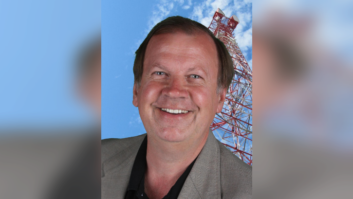FCC Looks to Update RF Exposure Rules
Nov 1, 2013 6:05 PM, By Jeremy Ruck, PE
A couple of years ago I discussed RF radiation safety as it applies to broadcasters. At that time, the Commission was still using its OET Bulletin 65 standard, which is a hybridization of the 1992 revision to the IEEE C95.1 standard combined with some elements of previous standards. The latest tome concerning updating and revising the standard was issued in March of this year, and spans some 202 pages of text. This release from the Commission continues the discussion started in ET Docket 03-137, which began a decade ago. Who denies that the wheels of government move slowly?

Although this process appears to still be far from over, there have been some changes in the way RF exposure is evaluated, and to the methods in which compliance with exposure limits are demonstrated. There are no changes at this time, however, to the maximum permissible exposure (MPE) limits for the controlled and uncontrolled environment conditions. The numeric limits recognized by the Commission differ from the current IEEE values over certain ranges. In addition, the Commission and the Institute use different formulae and units, but tend to arrive at similar numbers. To be in compliance with the terms of a license, one must comply with the FCC requirements; however, given that this is a science in a continual state of flux, it may be advisable to examine compliance relative to the IEEE values as well.
For instance, at AM frequency ranges the FCC limits are more stringent than the IEEE values. Through UHF frequencies, which include the transmissions of our television engineer friends as well as STL links, the situation is reversed. Generally this is a bigger issue for the TV guys because of their higher power transmissions, but areas where STL antennas are transmitting may be worth a look if they are on a building rooftop or in other areas potentially accessible to persons.
The MPE limits are, however, derived from specific absorption rate (SAR) values. In a nutshell, SAR looks at body tissues, and how they absorb non-ionizing radiation leading to heating. Under the March revision to the rules, the Commission sagely broadens the methodologies of compliance for fixed and mobile transmitters to permit the utilization of SAR in lieu of MPE measurements. So in essence, what has been done here is to increase the size of our toolbox.
Ongoing updates
When the previous rules were implemented, measurement of SAR within a body at a distance from an antenna, such as on the ground near an FM facility, the MPE values in terms of field strength or power density were derived. These values were easily measurable then, and continue to be so, with a varying array of equipment. As the science has advanced, however, developments in techniques have allowed for practical SAR measurement. Recognizing this fact, both methods will now be permissible, so the performed survey continues to remain valid providing no emitter changes have been made at your site.
While the SAR analysis may be somewhat more cost effective in some circumstances, the Commission specifically noted that “accepted” and “generic” procedures for determining SAR throughout a range of circumstances have yet to be developed. As a result, any procedures and methodologies utilized in such calculations will necessarily be evaluated on a case-by-case basis. As part of any showing along this line, the Commission notes that it must demonstrate that evaluation was made under all applicable operating configurations and exposure conditions, and whole and partial body limits must be considered as must near and far field situations. Since the potential variables could grow rather rapidly, it may make more sense to continue along the more “traditional” MPE methodology.
What is interesting to note, however, is picking-and-choosing the methodology circumstantially is verboten. Specifically the Commission will forbid demonstrating compliance via the traditional MPE method, and then coming back and claiming SAR is valid following an enforcement action. In other words, if MPE methods are used, and the Commission subsequently determines the MPE limits are exceeded, changing the tune and claiming that it was not a problem under SAR ain’t gonna fly. SAR will not be permissible to undermine enforcement of MPE limits. Such a situation would probably be much more applicable to portable or mobile devices, and not a fixed transmitter facility.
Two of the discussions that are most germane to broadcasters address the difference between the controlled and uncontrolled environments as well as responsibility under a multi-emitter situation. In the case of the former, the key to considering an environment as controlled, and thereby subject to the less restrictive higher tier limits, was that persons were fully aware of their exposure potential, and could exercise control over their exposure. The concern here is how “fully aware” is defined, and what was the origin of that awareness. Did it arrive from some form of osmosis, or was it definitively communicated.
In the initial proposals the Commission suggested awareness consisted of receiving verbal and written information concerning exposure as well as appropriate training regarding work practices to controlling or mitigating the exposure. This of course resulted in questions as to what constituted written information, and how do the licensees or responsible parties handle third party subcontractors and highly transient persons. The final decision is that workers subject to the higher tier must receive written and/or orally communicated information at the discretion of the responsible party as is necessary to ensure compliance with limits. The second prong is that appropriate training will provide a mechanism whereby persons can employ exposure control through administrative or engineering controls. Finally, the Commission is also proposing rules that result in more specific guidelines for the communication and training processes. We will return to this topic in a future column once things are more codified.
The discussion about multi-emitter site responsibility was also undertaken. The Commission specifically noted that in such cases, the rules do not specifically address how that responsibility is to be apportioned among those utilizing the site. While it was suggested in comments that one licensee hold the primary responsibility, the Commission noted that this is not the case, and all licensees must cooperate to ensure compliance. Moving forward, the Commission will be providing guidance in future revisions of OET Bulletin 65. In the meantime, no one is relieved from the special condition on construction permits and licenses, so this may be a good time to dust off the RF Safety Plan if you have not done so for a while.
In short, RF Safety, like all sciences, continues to evolve. Updating of the quasi archaic OET Bulletin 65 is definitely due, and the Commission is certainly working in this direction. Comments were due in September with reply comments due in November, so this will no doubt continue to be an ongoing topic of discussion for the foreseeable future.
Ruck is the principal engineer of Jeremy Ruck and Associates, Canton, IL.
November 2013
Build an effective back-up transmitter site, step inside WTMD, the FCC updates RF exposure rules, and Wheatstone baseband192 is explained….







